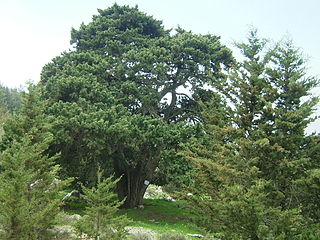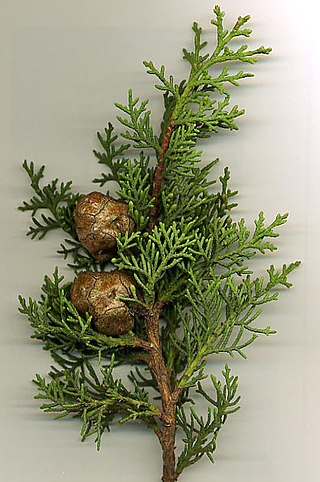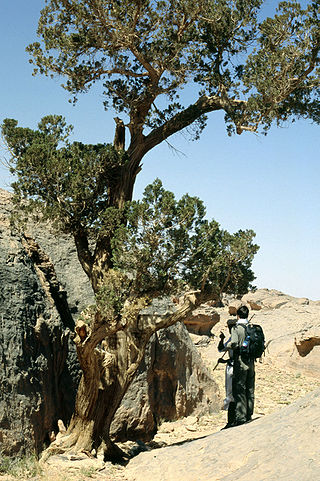Cypress is a common name for various coniferous trees or shrubs of northern temperate regions that belong to the family Cupressaceae. The word cypress is derived from Old French cipres, which was imported from Latin cypressus, the latinisation of the Greek κυπάρισσος (kyparissos). Cypress trees are a large classification of conifers, encompassing the trees and shrubs from the cypress family (Cupressaceae) and many others with the word cypress in their common name. Many cypress trees have needle-like, evergreen foliage and acorn-like seed cones.

Cupressus is one of several genera of evergreen conifers within the family Cupressaceae that have the common name cypress; for the others, see cypress. It is considered a polyphyletic group. Based on genetic and morphological analysis, the genus Cupressus is found in the subfamily Cupressoideae. The common name "cypress" comes via the Old French cipres from the Latin cyparissus, which is the latinisation of the Greek κυπάρισσος (kypárissos).

Cupressus sempervirens, the Mediterranean cypress, is a species of cypress native to the eastern Mediterranean region and Iran. Cupressus sempervirens is a seeded vascular plant, meaning that it contains both xylem and phloem. Since it is a seeded plant, it uses seeds to reproduce. It has many uses that can contribute to medicine and other things that are beneficial, whether that be the seeds that it produces or the oil that comes from the leaves. It is well adapted to the conditions and the environment that it lives in. Cupressus sempervirens is widely present in culture, most notably in Iran, where it is both a sacred tree and is a metaphor for "the graceful figure of the beloved".

Cupressus dupreziana, the Saharan cypress, or tarout, is a very rare coniferous tree native to the Tassili n'Ajjer mountains in the central Sahara desert, southeast Algeria, where it forms a unique population of trees hundreds of kilometres from any other trees. There are only 233 specimens of this endangered species, the largest about 22 m tall. The majority are estimated to be over 2000 years old, with very little regeneration due to the increasing desertification of the Sahara. Rainfall totals in the area are estimated to be about 30 mm annually. The largest one is named Tin-Balalan is believed to be the oldest tarout tree with a circumference of 12 meters or 36 feet.

Cupressus atlantica, the Moroccan cypress, is a rare coniferous tree endemic to the valley of the Oued n'Fiss river in the High Atlas Mountains south of Marrakech in western Morocco. The majority are old, with very little regeneration due to overgrazing by goats, and they are critically endangered.

Cupressus torulosa, commonly known as the Himalayan cypress or Bhutan cypress, is a species of cypress tree native to the mountainous northern regions of the Indian subcontinent, in the western Himalayas.

Choristoneura occidentalis is a species of moth of the family Tortricidae. It is found in the Democratic Republic of Congo, South Africa, Tanzania and Gambia.

Pseudocoremia suavis, the common forest looper, is a species of moth in the family Geometridae. It is regarded as being endemic to New Zealand. In 2007, however, the moth was found in west Cornwall, Great Britain, the first time it has been found outside of New Zealand.

Gravitarmata margarotana, the pine cone tortrix or pine twig moth, is a moth of the family Tortricidae. In Europe, it is found from England to Austria and Poland, east to the Baltic region to Russia, China, Korea and Japan.

Blastesthia posticana is a moth of the family Tortricidae. It is found from northern and central Europe to eastern Russia.
Retinia monopunctata is a moth of the family Tortricidae. It is found in Japan, northern China and Russia.

Zeiraphera ratzeburgiana, the spruce bud moth or Ratzeburg tortricid, is a moth of the family Tortricidae. It is found from northern and central Europe to eastern Russia and China. Zeiraphera ratzeburgiana is a taxonomically similar species to Zeiraphera canadensis and can only be distinguished by an anal comb found in Z. canadensis.

Thera cupressata, the cypress carpet, is a moth of the family Geometridae. It is found in southern and western Europe, including Great Britain, Germany, France, Switzerland, Italy, Slovenia, Croatia, Greece and Spain.
Eupithecia cupressata is a moth in the family Geometridae. It is found in the Alameda, Mendocino, and Monterey counties in central coastal California.

Ancylis diminutana, the small festooned roller, is a moth of the family Tortricidae. It was described by Adrian Hardy Haworth in 1811. In Europe, it has been recorded from Great Britain, Ireland, the Benelux, Scandinavia, the Baltic region, Russia, Poland, the Czech Republic, Hungary, Romania, Slovenia and Switzerland. It is also found in North America.

Henricus fuscodorsana, the cone cochylid moth, is a species of moth of the family Tortricidae. It is found in western North America, where it has been recorded from Arizona, British Columbia, California, Colorado, Idaho, Oregon and Washington.
Archips alberta is a species of moth of the family Tortricidae first described by James Halliday McDunnough in 1923. It is found in North America, where it has been recorded across boreal Canada, south through the mountains to Utah. The habitat consists of coniferous forests.
Argyrotaenia cupressae is a species of moth of the family Tortricidae. It is found in the United States, where it has been recorded from California.

Cnephasia cupressivorana is a species of moth of the family Tortricidae. It is found on Corsica, Sardinia, Sicily and in Belgium, France, Spain, Italy, Switzerland, Austria, Croatia, Slovenia, Albania, Romania, North Macedonia, Greece, Asia Minor and Kyrgyzstan.

Acleris implexana is a species of moth of the family Tortricidae. It is found in Norway, Sweden, Finland, Russia and North America, where it has been recorded from Quebec to British Columbia and adjacent areas of the United States.















